On April 2nd 2009 will be launching day for two arch rival Graphics chip maker. ATI will launch their latest bid to narrow performance gap to Nvidia Geforce 280GTX with ATI Radeon HD4890. And Nvidia suddenly rush to destroy world attention to ATI's card with unplanned Geforce 275GTX. HD4890 is believed available for review and sale on launch day. But for Nvidia as it just a destroyer, some source said it only produced very limited number for reviewer only and available on store some weeks later. As a trusted site, Anandtech able to received both card to compared head to head. Here for you.
I'm not really sure why we have NDAs on these products anymore. Before we even got our Radeon HD 4890, before we were even briefed on it, NVIDIA contacted us and told us that if we were working on a review to wait. NVIDIA wanted to send us something special.

Then in the middle of our Radeon HD 4890 briefing what do we see but a reference to a GeForce GTX 275 in the slides. We hadn't even laid hands on the 275, but AMD knew what it was and where it was going to be priced.
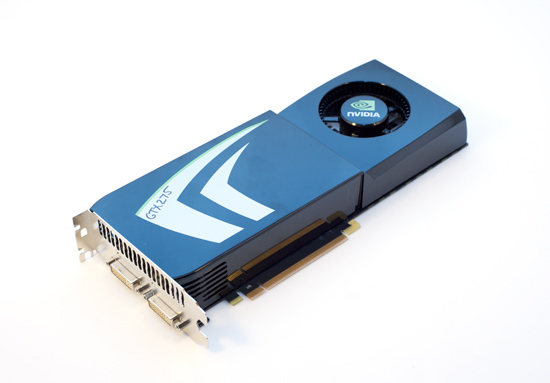 If you asked NVIDIA what the Radeon HD 4890 was, you'd probably hear something like "an overclocked 4870". If you asked AMD what the GeForce GTX 275 was, you'd probably get "half of a GTX 295".
If you asked NVIDIA what the Radeon HD 4890 was, you'd probably hear something like "an overclocked 4870". If you asked AMD what the GeForce GTX 275 was, you'd probably get "half of a GTX 295".The truth of the matter is that neither one of these cards is particularly new, they are both a balance of processors, memory, and clock speeds at a new price point.
As the prices on the cards that already offered a very good value fell, higher end and dual GPU cards remained priced significantly higher. This created a gap in pricing between about $190 and $300. AMD and NVIDIA saw this as an opportunity to release cards that fell within this spectrum, and they are battling intensely over price. Both companies withheld final pricing information until the very last minute. In fact, when I started writing this intro (Wednesday morning) I still had no idea what the prices for these parts would actually be.
Now we know that both the Radeon HD 4890 and the GeForce GTX 275 will be priced at $250. This has historically been a pricing sweet spot, offering a very good balance of performance and cost before we start to see hugely diminishing returns on our investments. What we hope for here is a significant performance bump from the GTX 260 core 216 and Radeon HD 4870 1GB class of performance. We'll wait till we get to the benchmarks to reveal if that's what we actually get and whether we should just stick with what's good enough.
We suspect that this will be quite an interesting battle and we might have some surprises on our hands. NVIDIA has been talking about their new drivers which will be released to the public early Thursday morning. These new drivers offer some performance improvements across the board as well as some cool new features. Because it's been a while since we talked about it, we will also explore PhysX and CUDA in a bit more depth than we usually do in GPU reviews.
We do want to bring up availability. This will be a hard launch for AMD but not for NVIDIA (though some European retailers should have the GTX 275 on sale this week). As for AMD, we've seen plenty of retail samples from AMD partners and we expect good availability starting today. If this ends up not being the case, we will certainly update the article to reflect that later. NVIDIA won't have availability until the middle of the month (we are hearing April 14th).
NVIDIA hasn't been hitting their launches as hard lately, and we've gotten on them about that in past reviews. This time, we're not going to be as hard on them for it. The fact of the matter is that they've got a competitive part coming out in a time frame that is very near the launch of an AMD part at the same price point. We are very interested in not getting back to the "old days" where we had paper launched parts that only ended up being seen in the pages of hardware review sites, but we certainly understand the need for companies to get their side of the story out there when launches are sufficiently close to one another. And we're certainly not going to fault anyone for that. Not being available for purchase is it's own problem.
From the summer of 2008 to today we've seen one of most heated and exciting battles in the history of the GPU. NVIDIA and AMD have been pushing back and forth with differing features, good baseline performance with strengths in different areas, and incredible pricing battles in the most popular market segments. While AMD and NVIDIA fight with all their strength to win customers, the real beneficiary has consistently been the end user. And we certainly feel this launch is no exception. If you've got $250 to spend on graphics and were wondering whether you should save up for the GTX 285 or save money and grab a sub-$200 part, your worries are over. There is now a card for you. And it is good.
The Cards and The Test
In the AMD department, we received two cards. One was an overclocked part from HIS and the other was a stock clocked part from ASUS. Guess which one AMD sent us for the review. No, it's no problem, we're used to it. This is what happens when we get cards from NVIDIA all the time. They argue and argue for the inclusion of overclocked numbers in GPU reviews when it's their GPU we're looking at. Of course when the tables are turned so are the opinions. We sincerely appreciate ASUS sending us this card and we used it for our tests in this article. The original intent of trying to get a hold of two cards was to run CrossFire numbers, but we only have one GTX 275 and we would prefer to wait until we can compare the two to get into that angle.
The ASUS card also includes a utility called Voltage Tweaker that allows gamers to increase some voltages on their hardware to help improve overclocking. We didn't have the chance to play with the feature ourselves, but more control is always a nice feature to have.
For the Radeon HD 4890 our hardware specs are pretty simple. Take a 4870 1GB and overclock it. Crank the core up 100 MHz to 850 MHz and the memory clock up 75 MHz to 975 MHz. That's the Radeon HD 4890 in a nutshell. However, to reach these clock levels, AMD revised the core by adding decoupling capacitors, new timing algorithms, and altered the ASIC power distribution for enhanced operation. These slight changes increased the transistor count from 956M to 959M. Otherwise, the core features/specifications (texture units, ROPs, z/stencil) remain the same as the HD4850/HD4870 series.
Most vendors will also be selling overclocked variants that run the core at 900 MHz. AMD would like to treat these overclocked parts like they are a separate entity altogether. But we will continue to treat these parts as enhancements of the stock version whether they come from NVIDIA or AMD. In our eyes, the difference between, say, an XFX GTX 275 and an XFX GTX 275 XXX is XFX's call; the latter is their part enhancing the stock version. We aren't going to look at the XFX 4890 and the XFX 4890 XXX any differently. In doing reviews of vendor's cards, we'll consider overclocked performance closely, but for a GPU launch, we will be focusing on the baseline version of the card.
On the NVIDIA side, we received a reference version of the GTX 275. It looks similar to the design of the other GT200 based hardware.
Under the hood here is the same setup as half of a GTX 295 but with higher clock speeds. That means that the GTX 275 has the memory amount and bandwidth of the GTX 260 (448-bit wide bus), but the shader count of the GTX 280 (240 SPs). On top of that, the GTX 275 posts clock speeds closer to the GTX 285 than the GTX 280. Core clock is up 31 MHz from a GTX 280 to 633 MHz, shader clock is up 108 MHz to 1404 MHz, and memory clock is also up 108 MHz to 2322. Which means that in shader limited cases we should see performance closer to the GTX 285 and in bandwicth limited cases we'll still be faster than the GTX 216 because of the clock speed boost across the board.
Rather than just an overclock of a pre-existing card, this is a blending of two configurations combined with an overclock from the two configurations from which it was born. And sure, it's also half a GTX 295, and that is convenient for NVIDIA. It's not just that it's different, it's that this setup should have a lot to offer especially in games that aren't bandwidth limited.
That wraps it up for the cards we're focusing on today. Here's our test system, which is the same as for our GTS 250 article except for the addition of a couple drivers.
The New $250 Price Point: Radeon HD 4890 vs. GeForce GTX 275
Here it is, what you've all been waiting for. And it's a tie. Pretty much. These cards stay pretty close in performance across the board.
Looking at Age of Conan, we see something we didn't expect. NVIDIA is actually performing on par with AMD in this benchmark. NVIDIA's come a long way to closing the gap in this one, and for this comparison it's paid off a bit. Despite the fact that this one is essentially a tie, NVIDIA gets props for being competitive here.
While NVIDIA usually owns Call of Duty benchmarks, the 4890 outpaces the GTX 275 at 16x10 and 19x12 while the GTX 275 leads at the 30" panel resolution. As long as its still playable, then this isn't a huge deal, but the fact that most people have lower resolution monitors who might want one of these GPUs isn't in NVIDIA's favor.
Crysis Warhead is really close in performance again.
AMD leads Fallout 3, and this is the first game we've seen any consistent significant difference favoring one card over another.
FarCry 2 takes us back to the norm with both cards performing essentially the same.
The 4890 does have a pretty hefty lead under Race Driver GRID. The gap does close at higher resolution, but it's still a gap in AMD's favor.
Left4Dead is also pretty much a tie with the card you would want changing depending on the resolution of your monitor.
Overall, this is really a wash. These parts are very close in performance and very competitive.
What will an Extra $70 Get You? Radeon HD 4890 vs. Radeon HD 4870 1GB
The short answer is more performance. We see across the board improvement in performance from the highly clocked 4890. In some games the improvement is large while in others it is just a nice perk. But moving up to this price point we do still have diminishing returns. This isn't as significant as it is up above $300, but it's still a big price gap to cover for the gain. Only individual gamers can really decided whether they would benefit from the added performance enough.
Another Look at the $180 Price Point: 260 core 216 vs. 4870 1GB
With the change in performance with the 185 drivers from NVIDIA, we wanted to breakout one of the other most important price points. With lower resolution performance sometimes showing degraded performance and higher resolutions popping up with improvements, this price point is worth exploring.
Overall, it looks like the 4870 1GB is just a little bit faster in one or two games, but these cards are still pretty well matched after the new driver. the scaling differences really wouldn't change our minds either way. Both of these cards are good options.
Putting this PhysX Business to Rest
Let me put things in perspective. Remember our Radeon HD 4870/4850 article that went up last year? It was a straight crown-robbing on ATI’s part, NVIDIA had no competitively priced response at the time.
About two hours before the NDA lifted on the Radeon HD 4800 series we got an urgent call from NVIDIA. The purpose of the call? To attempt to persuade us to weigh PhysX and CUDA support as major benefits of GeForce GPUs. A performance win by ATI shouldn’t matter, ATI can’t accelerate PhysX in hardware and can’t run CUDA applications.
The argument NVIDIA gave us was preposterous. The global economy was weakening and NVIDIA cautioned us against recommending a card that in 12 months would not be the right choice because new titles supporting PhysX and new CUDA applications would be coming right around the corner.
The tactics didn’t work obviously, and history showed us that despite NVIDIA’s doomsday warnings - Radeon HD 4800 series owners didn’t live to regret their purchases. Yes, the global economy did take a turn for the worst, but no - NVIDIA’s PhysX and CUDA support hadn’t done anything to incite buyer’s remorse for anyone who has purchased a 4800 series card. The only thing those users got were higher frame rates. (Note that if you did buy a Radeon HD 4870/4850 and severely regretted your purchase due to a lack of PhysX/CUDA support, please post in the comments).
This wasn’t a one time thing. NVIDIA has delivered the same tired message at every single opportunity. NVIDIA’s latest attempt was to punish those reviewers who haven’t been sold on the PhysX/CUDA messages by not sending them GeForce GTS 250 cards for review. The plan seemed to backfire thanks to one vigilant Inquirer reporter.
More recently we had our briefing for the GeForce GTX 275. The presentation for the briefing was 53 slides long, now the length wasn’t bothersome, but let’s look at the content of the slides:
You could argue that NVIDIA truly believes that PhysX and CUDA support are the strongest features of its GPUs. You could also argue that NVIDIA is trying to justify a premium for its much larger GPUs rather than having to sell them as cheap as possible to stand up to an unusually competitive ATI.
NVIDIA’s stance is that when you buy a GeForce GPU, it’s more than just how well it runs games. It’s about everything else you can run on it, whether that means in-game GPU accelerated PhysX or CUDA applications.
Maybe we’ve been wrong this entire time. Maybe instead of just presenting you with bar charts of which GPU is faster we should be penalizing ATI GPUs for not being able to run CUDA code or accelerate PhysX. Self reflection is a very important human trait, let’s see if NVIDIA is truly right about the value of PhysX and CUDA today.
We normally hold manufacturers accountable to their performance claims, well it was about time we did something about these other claims - shall we?
Our goal was simple: we wanted to know if GPU accelerated PhysX effects in these titles was useful. And if it was, would it be enough to make us pick a NVIDIA GPU over an ATI one if the ATI GPU was faster.
To accomplish this I had to bring in an outsider. Someone who hadn’t been subjected to the same NVIDIA marketing that Derek and I had. I wanted someone impartial.
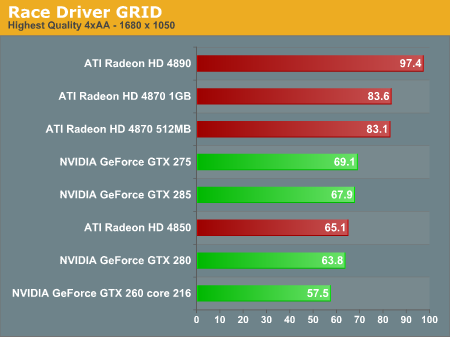
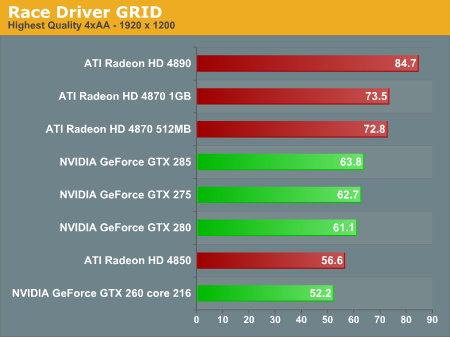
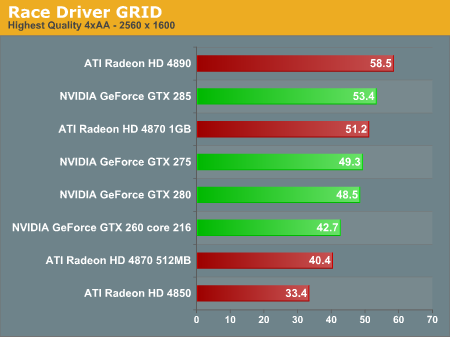
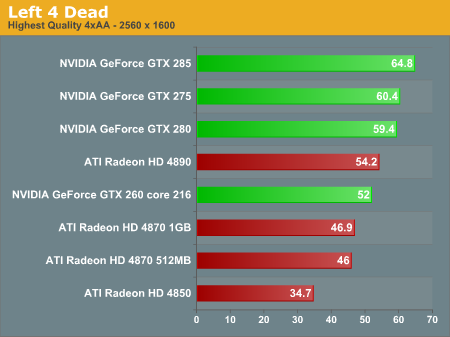
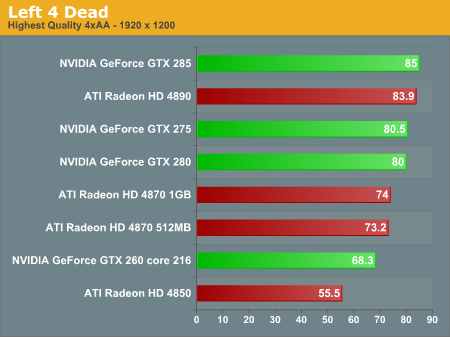
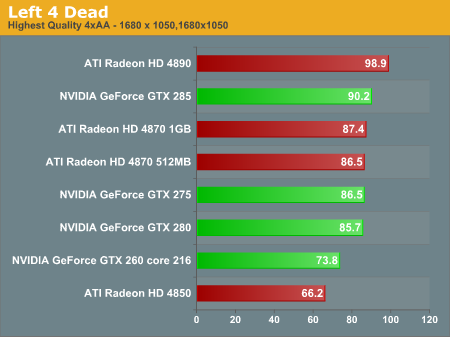
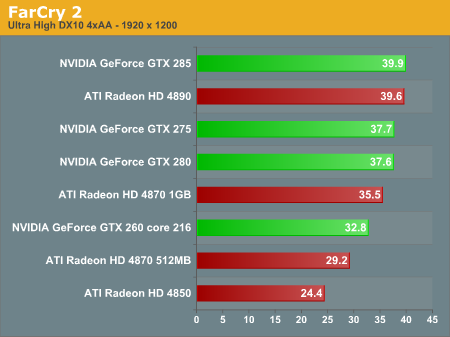

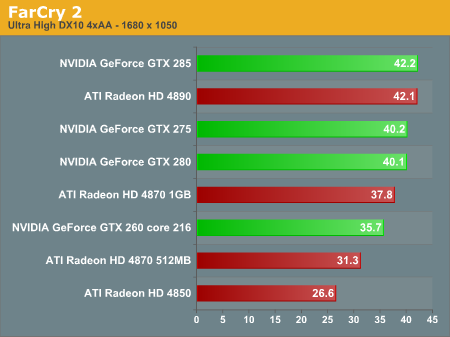
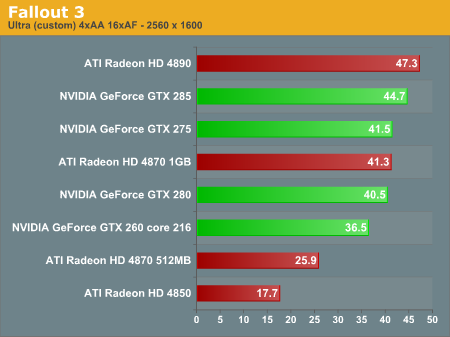
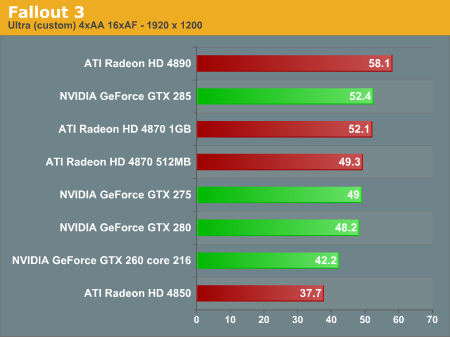
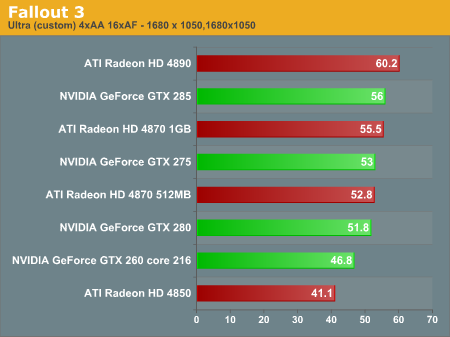

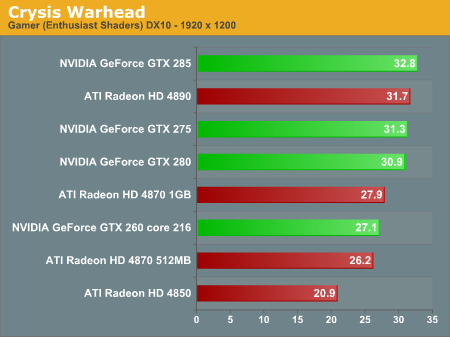
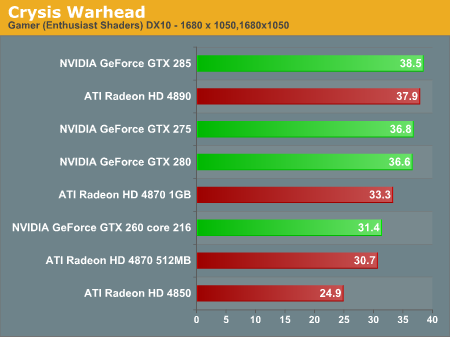

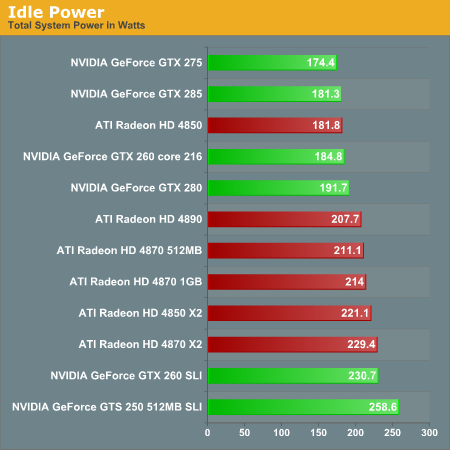

Final Words
NVIDIA is competitive at this new price point of $250 depending on what resolution you look at. We also see some improvement from NVIDIA's new 185 series driver and get a new feature to play with in the form of Ambient Occlusion. We did look at PhysX and CUDA again, and, while we may be interested in what is made possible by them, there is still a stark lack of compelling content that takes advantage of these technologies. We can't recommend prioritizing PhysX and CUDA over performance, and performance is where a GPU needs to compete. Luckily for NVIDIA, the GTX 275 does.
The fact that its worst-case performance is still better than the GTX 260 core 216 and in the best case, it can hit that of the GTX 280 was a plus for the GTX 275. It often posted performance more in line with its bigger brothers than a $50+ cheaper part. This is pretty sweet for a $250 card, especially as many games these days rely very heavily on shader performance. The GeForce GTX 275 is a good fit for this price point, and is a good option. But then there's the Radeon HD 4890.
The 4890, basically a tweaked and overclocked 4870, does improve performance over the 4870 1GB and puts up good competition for the GTX 275. On a pure performance level the 4890 and GTX 275 trade blows at different resolutions. The 4890 tends to look better at lower resolutions while the GTX 275 is more competitive at high resolutions. At 1680 x 1050 and 1920 x 1200 the 4890 is nearly undefeated. At 2560 x 1600, it seems to be pretty much a wash between the two cards.
At the same time, there are other questions, like that of availability. With these parts performing so similarly, and price being pretty well equal, the fact that AMD parts can be bought starting today and we have to wait for the NVIDIA parts is an advantage for AMD. However, we have to factor in the fact that AMD driver support doesn't have the best track record as of late for new game titles. Add in the fact that NVIDIA's developer relations seem more effective than AMD's could mean more titles that run better on NVIDIA hardware in the future. So what to go with? Really it depends on what resolutions you're targeting and what the prices end up being. If you've got a 30" display then either card will work, it's just up to your preference and the items we talked about earlier. If you've got a 24" or smaller display (1920x1200 or below), then the Radeon HD 4890 is the card for you.
AMD tells us that most retailers will feature mail in rebates of $20, a program which was apparently underwritten by AMD. Could AMD have worried they weren't coming in at high enough performance late in the game and decided to try and throw an extra incentive in there? Either way, not everyone likes a mail in rebate. I much prefer the instant variety and mail-in-rebate offers do not make decisions for me. We still compare products based on their MSRP (which is likely the price they'll be back at once the rebate goes away). This is true for both AMD and NVIDIA parts.
There will also be overclocked variants of the GTX 275 to compete with the overclocked variants from AMD. The overclock on the AMD hardware is fairly modest, but does make a difference and the same holds true for the GTX 275 products in early testing. We'll have to take a look at how such parts compare in the future along with SLI and CrossFire. In the meantime, we have another interesting battle at the $250 price point.



No comments:
Post a Comment